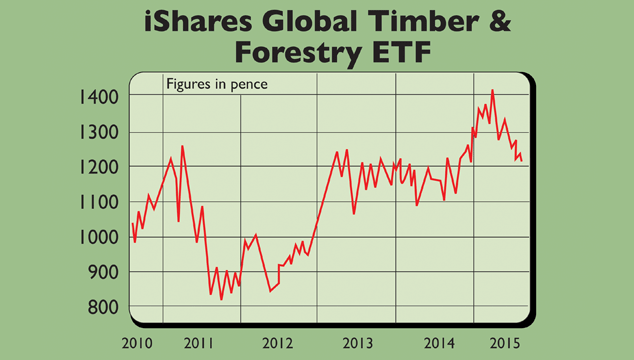Why you should invest in forestry – and what to buy
With demand for forest products guaranteed, smart investors will snap up key firms servicing the industry, says Jonathan Compton.

With demand for forest products guaranteed, smart investors will snap upkey firms servicing the industry, says Jonathan Compton.
There's a market adage that "if it's in the press, it's in the price". In other words, a torrent of favourable or adverse media comment will already have been reflected in the share price. At a recent meeting with a successful private client manager and a seriously good institutional investor, the first admitted that he never looked for the best investment opportunities for his clients, nor did he carry out any analysis, preferring to rely on often low-grade research and consensus. Why? Because his clients expected their portfolios to be concentrated in companies whose names or products they knew, and in sectors and countries (usually via funds) where there had been favourable media coverage.
Just as depressingly, the institutional investor admitted that for all the considerable resources available to his firm, in reality there was a high dependency on analysts at investment banks. In order to make money, these in turn had to focus on larger companies with high stockmarket turnover and on markets and sectors that investors were likely to buy because they had already risen strongly.
Subscribe to MoneyWeek
Subscribe to MoneyWeek today and get your first six magazine issues absolutely FREE

Sign up to Money Morning
Don't miss the latest investment and personal finances news, market analysis, plus money-saving tips with our free twice-daily newsletter
Don't miss the latest investment and personal finances news, market analysis, plus money-saving tips with our free twice-daily newsletter
Both agreed that investment management has never been narrower in focusing on bonds and equities and within that a small number of currently fashionable, well-known companies hearsay evidence that, once again, the industry is mired in a "buy high, sell low" strategy.
The robber barons' legacy
Reversing this approach should therefore be financially rewarding. Find a major sector where demand for its products is guaranteed (as opposed to, say, the market for tape recorders), which has minimal media or analyst coverage, and is thus under-owned by institutions.
One sector that meets all these criteria is forest products, with its many sub-categories, including timber (construction), pulp (newsprint), myriad paper products, cartons, fibre and cellulose materials.
Long-term returns have varied from modestly steady to deeply unexciting, both in absolute terms and relative to bonds and equities. In the UK, for example, the price index for softwood sawn logs has risen by less than 2% a year over the last 30 years, and in real terms is down by a third. Yet here and globally, there has been a steady improvement in forest product prices over the last five years. This should continue.
Much of the industry has beenbattered by significant structuralchanges. The most important use of forest products is in construction.When Japan's bubble burst in 1990 itwas the world's largest importer of wood.The prolonged economic slump that followed particularly in housing starts has reduced demand today to half its peak level. Then there is the internet.
Its rapid development proved a body blow to the next two most important uses of forestry, pulp and paper. Globally, the newspaper industry has been suffering a prolonged squeeze on circulation as readers go online. The same applied to other paper products, be it the Kindle crushing demand for physical books, or email replacing letters; to anyone under 40, writing letters is for nerds. Fashion has also affected furniture and panels. Both have suffered competition from other materials most businesses now use metal and plastic chairs.
The industry thought that these changes were cyclical. So as demand and prices weakened, the response was to repeat the mistakes that all commodity companies appear cyclically doomed to follow (look at the large mining groups now), by increasing production, slashing capital expenditure and cutting dividends. Worse, the industry did itself no favours with the politicians or public, as leading firms behaved like 19th-century robber barons.
The now bankrupt Chinese/Canadian group Sino-Forest, and Australia's Gunns, were found tohave falsified accounts, bribed politicians and threatened opponents. Cutting down trees will never be popular, even though good forestry practice requires thinning and replanting to be sustainable, but the industry dragged itsheels in implementingoften necessary environmental and related legislation and so brought upon itself sometimes draconian regulation.
No shortage of trees
Surprisingly, despite huge population growth and industrialisation, forests still cover 31% of the world's land area. The two most forested continents are Latin America at 49% and Europe at 45% even in overpopulated, intensively farmedGreat Britain, there are three million hectares of forests, covering 13% of the land area. Thus there would seem to be no shortage of trees.
Yet much of this forest cover is scrub, such as northern Russia's stumpy taiga ecoregion, or is on inaccessible mountain ranges or in swamps; moving logs is expensive. Moreover, although controls over illegal logging are often poorly implemented, the major consumers, which are mostly developed countries, have ever-stricter controls over sourcing from renewable forests, driven in part by changing public perceptions about forest exploitation, preservation and sustainability.
Then there is politics. In the last 50 years, the Gobi desert has advanced to within 50 miles of Beijing; choking sandstorms are a standard summer highlight. Both China's government and even more rapacious ones in other developing countries have realised that the wholesale removal of forest cover causes soil degradation, erosion, silted-up rivers and also affects general health. Thus wood supply is becoming constricted, leaving the field to the top three better and more sustainable forest-growing areas of North America, Scandinavia and Russia.
On the demand side, many of the problems have eased, or even reversed. Three of the world's largest net forestry importers are China, India and Japan; bad local practices in the first two ensure that this is maintained. Asia's demand will continue to rise and its wood deficiency worsen. Although there are some significant local producers, such as Indonesia, much of its wood production is inappropriate, or too expensive for construction, paper or furniture.
The outlook for demand for construction is good: in Japan, new house building has resumed; the larger American housing market continues its gradual recovery; while although house building in the European Union is flat, a mild improvement is expected.
In 2008, an earthquake registering 8.3 on the Richter scale struck China's Sichuan province, killing more than 70,000 people. A slightly weaker earthquake destroyed the centre of New Zealand's second city Christchurch in 2011, and this year there have been devastating earthquakes in Nepal. In all three countries there was wholesale destruction of buildings and infrastructure, which will take years to repair. Yet the extentof the damage need not have happened. The modern buildings collapsed: those with wooden frames fared much better.
Japan sits at the meeting point of major tectonic plates, so is notorious for earthquakes. Until 1945 the dominant building material was wood. Today, Japan is a leader in developing high-rise steel buildings resilient even to large earthquakes, yet it is now experimenting with wooden structures, including a mini (seven-storey) skyscraper.
Wood also fell out of favour for building in Japan and elsewhere because of fire and insect damage. Now it is relatively easy to make wooden structures fire resistant and virtually insect proof. Governments in earthquake zones of which there are many are looking again at wooden construction, because long term it may be cheaper and save lives.
The upside of climate change
The decline in demand for physical newspapers seems unavoidable, but demand for paper is showing a recovery. Every office worker knows that modern computers render paper files redundant. Yet the reality is that cheap desktop printers mean the typical employee is churning out more paper than ever before. Then there is packaging.
By 1990, plastic wrapping became thede-rigueur material for everythingfrom food to most white goods.Yet governments have becomeconcerned less perhaps about the ecological impact (though they aregetting there) but more about the disposal costs of vast quantities ofplastic; hence increasing legislation to encourage recyclable or disposablepaper packaging.
Another "plus point" is climate change. Although its causes and speed remained mired in controversy and the treaties have more holes than a sieve, there is a steady move among world leaders at the likes of G7 meetings towards renewable energy sources and the gradual phasing out of fossil fuels.
While there are many reports and much dubious data on the investment impact of global warming (Mercers suggests it will affect annual investment returns over the next 35 years by +0.4% and +0.2% for the health and IT sectors, and -0.7% and -2.5% for consumer discretionary and utilities), the overall winner of all forecasts is renewables especially forestry.
Meanwhile, after many years of pig-headedness the forestry industry has gradually managed to improve its act by closing excess capacity, from sawmills to pulp and packaging plants. The most damaging effects of forestry-related businesses, such as bleaching paper, have either been improved or curbed. Many firms have gone to the wall, and more still have been swallowed by competitors.
But for the first time in decades the industry is in reasonable financial shape, with supply and demand much better balanced. Themain risk that remains is that demand forecasts are too depressed (but this may be temporarily offset by lower than expected demand from China, the world's largest net importer of forestry products). As always after a prolonged period of price weakness, institutional interest and research remains minuscule.
The sole and surprising exception in the UK has been the Church of England. Its investment portfolio is more usually associated with disastrous losses, such as in 2008 and in the late 1980s. Yet performance for 2014 was good, and 4% of the portfolio was invested in timber and forestry, which produced a 22.3% return.
British wood the patriot's choice
There is a strong case for UK investors to consider buying local woodland. It's patriotic, for a start. And forest products rank among the top five largest imports into the UK, causing a deficit of £5.5bn a year. Although woodland prices have risen, they remain relatively cheap, with good blocks available at fair prices in the north of England, Wales and especially Scotland.
The simple price per acre has little use as a guide (£2,500-£10,000), given the variables such as grants, the age of the forest or accessibility. Then there is the type of tree grown. Horse chestnut is useless for almost anything beyond traditional paling fences and if the average temperature in England rises by more than 2C, every Scots pine south of Manchester will die.
Yet for £50,000 to £100,000 an investor can buy a small wood, or better still can combine with friends to acquire more and achieve scale.For parents wishing to pass on money to their children, the inheritance tax (IHT) advantages are excellent and the tax regime overall, from capital gains through to income tax, is very favourable. Often there are planting grants, which help defray necessary costs, such as fencing, trimming and insurance.
There are three other factors that make owning a forest appealing. Current expectations of initial returns are around 5%-8% a year over a 20-year period. Then there's the selling. In most agricultural markets the farmer must sell his grain or pig within a narrow timeframe.
By contrast, the forest owner can choose when to sell, depending on personal requirements and market prices. Finally, and unlike equities or bonds, a forest is an asset to be enjoyed in myriad ways, however you like naked, in a tutu, or wearing a gorilla suit because even as you romp, it adds a few more pennies to its value every single second.
The six stocks to buy now
Those investors who want to own their five acres of heaven locally, or even overseas, should start by contacting a fully qualified specialist chartered surveyor. These can be found on the website for the Royal Institution of Chartered Surveyors. There are also specialist firms that will help to find the right forest then manage it on your behalf, such as Forestry Investment Management (FIM).
There are many schemes advertised to invest in forestry offshore, from a slice of virgin jungle in Africa to saving the planet with new plantations. But many are scams and I would avoid them all because I have yet to find one that has worked.
Pooled timber funds are available, managed by FIM and others for smaller amounts, but these are unregulated collectives so there is little or no protection from the watchdog, or compensation if events turn sour. In the UK there is a handful of listed timber funds, but none appeal if only because of their poor five-yeartrack records.
On a more positive note, there is an easy route via exchange-traded funds (ETFs), and the mother ship is the iShares Global Timber & Forestry UCITS ETF (LSE: WOOD), which holds around 26 investments in companies and vehicles around the world. The current yield is 2.1%. There is only one significant UK company in the sector the well-run DS Smith (LSE: SMDS), a pan-European leader in corrugated boxes with a £3.8bn market cap.

Profit growth has been very steady in a volatile industry, hence for the last five years it has enjoyed a premium valuation. It yields 2.9%.Oversees there are more than 200 listed forestry-related companies with a market capitalisation greater than $250m.
The better ones tend to be found in the major forestry countries. Most have reasonable to good yields. Canada's West Fraser Timber (TSE: WFT) has been a stellar performer, largely because its forests are near good Pacific Ocean port facilities, thus it is well positioned to export to the all-important Asian market. Another pure play is the venerable Weyerhaeuser (NYSE: WY).
During the forestry slump many companies were forced, or opted, to become Real Estate Investment Trusts (Reits), one consequence of which is that the majority of profits must be paid out every year. Weyerhaeuser owns seven million acres of forests directly, manages another seven million for other companies, and has a market cap of $7bn. The yield is 3.8%.
Finland is one of the world's most important forestry regions and two large companies there are worth a look. The first is UPM Kymmene Oyj (Helsinki: UPM1V), which manufactures a wide range of forestry products globally, from sticky labels to plywood. It has been a consolidator and has spent the last five years rationalising its sometimes extended operations. It carries a juicy 4.4% yield.
The other is Stora Enso (Helsinki: STERV), a global leader in two of the 'wrong' sectors paper for books and newsprint. Both, however, are profitable and it operates in many other segments that have a better outlook for growth from boards and packaging to speciality woods for building.The yield is 3.6%.
Jonathan Compton spent 30 years in senior positions in fund managementand stockbroking.
Jonathan Compton was MD at Bedlam Asset Management and has spent 30 years in fund management, stockbroking and corporate finance.
-
 UK sold house prices fall again amid mortgage rates uncertainty, ONS House Price Index shows
UK sold house prices fall again amid mortgage rates uncertainty, ONS House Price Index showsNews The latest Office for National Statistics (ONS) analysis of UK sold house prices data showed they remained down year-on-year.
By Henry Sandercock Published
-
 UK inflation slowed again in March – but a rate cut could be some months away
UK inflation slowed again in March – but a rate cut could be some months awayThe latest Consumer Price Index (CPI) data came in at 3.2% for March. This was slightly higher than some economists expected, but takes us closer to the Bank of England’s 2% inflation target.
By Katie Williams Published